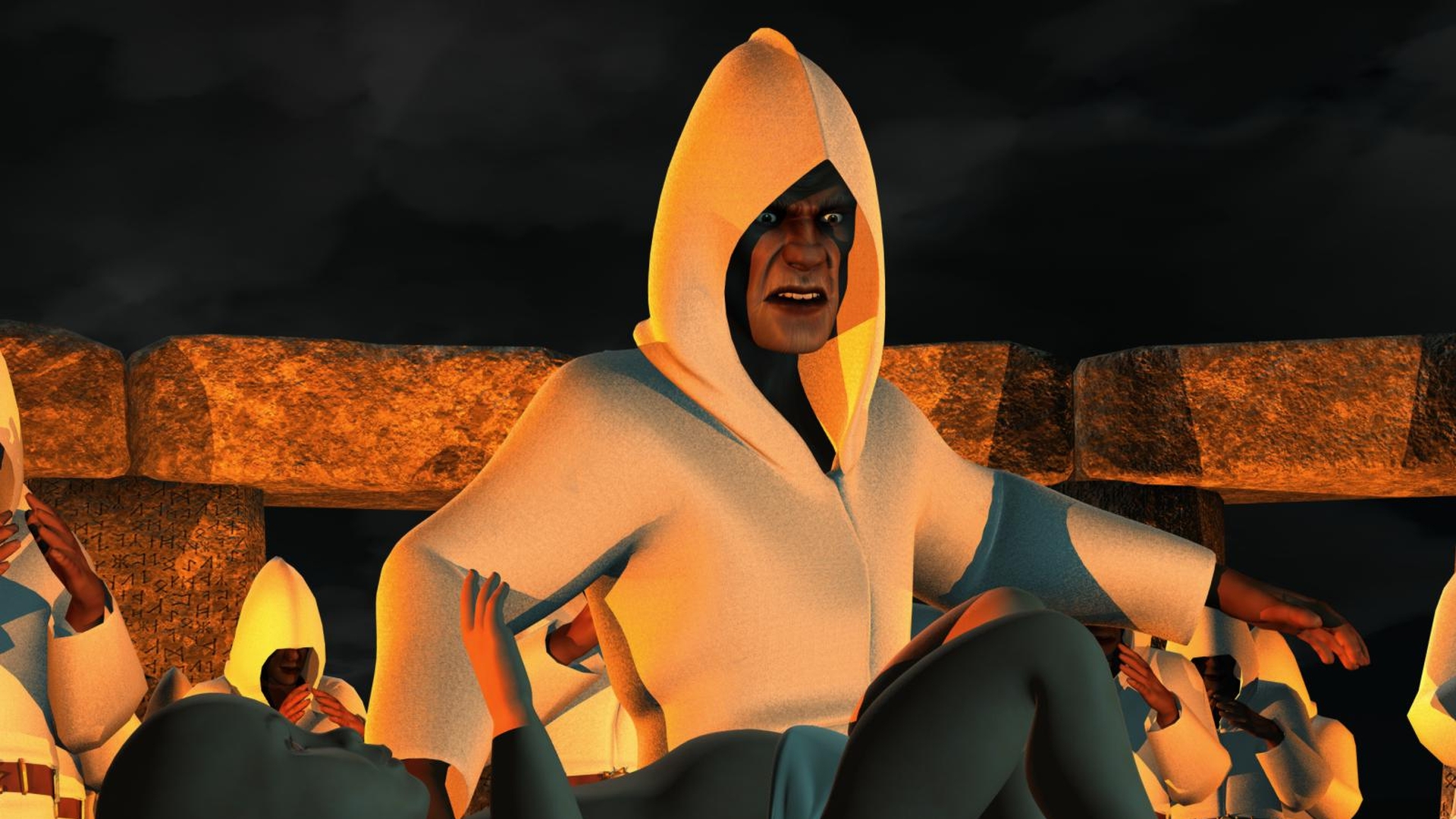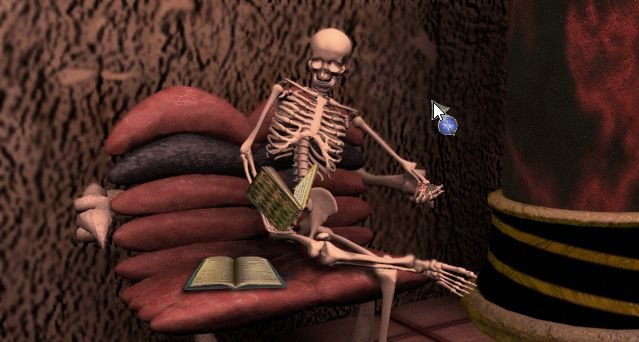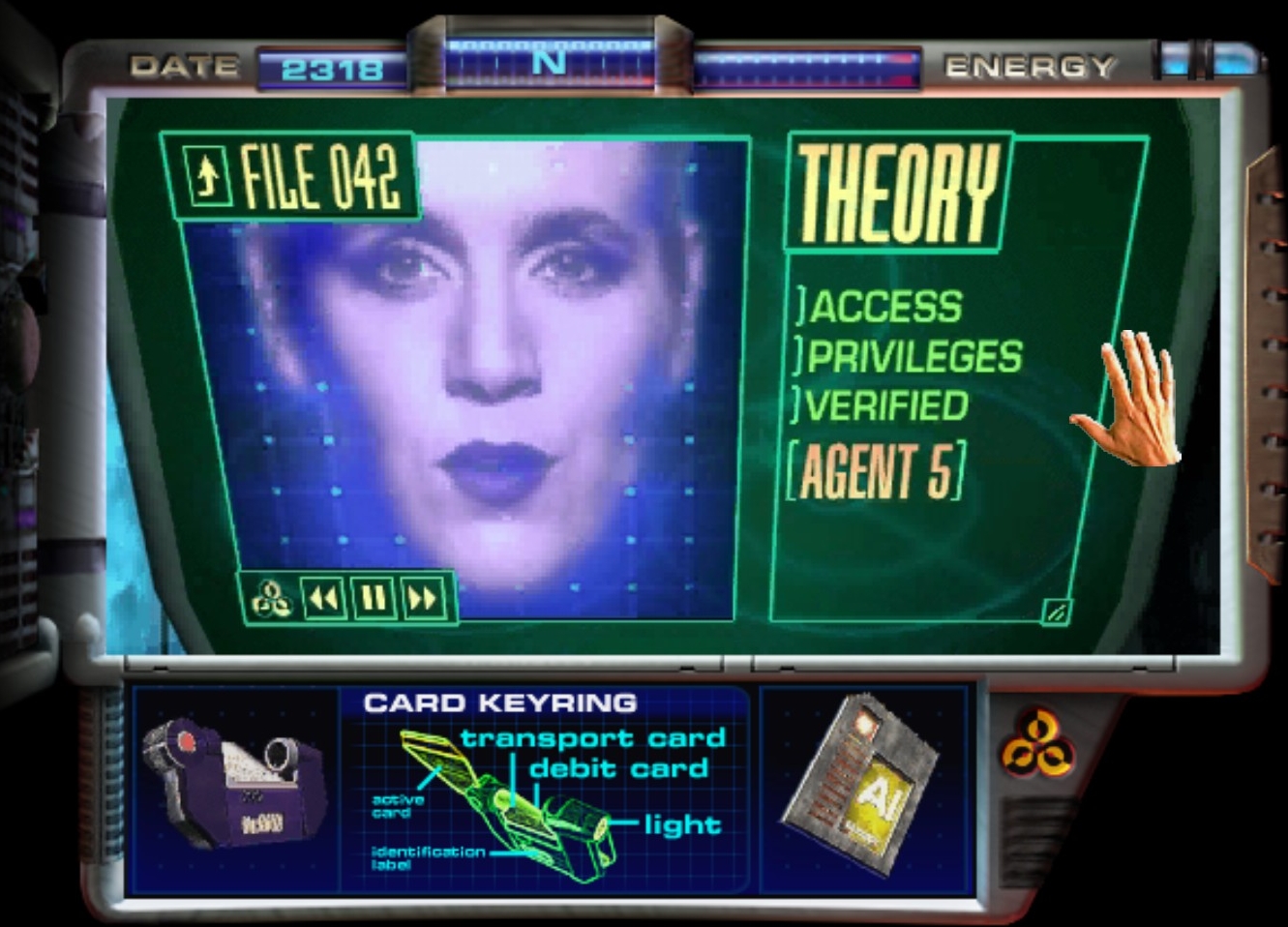Jankcore is the new aesthetic
Curators of forgotten, flawed adventures and FMV are ensuring they will never die.

Not long after I start The Mystery of the Druids, my caustic detective character, Brent Halligan, steals money from a bum after mixing medical-grade ethanol into his flask. After the guilt abated, I put my little moral mishap behind me and, over the next few hours, realized I was playing a work of art: a rich point-and-click smorgasbord of glitches, gorgeous background art, '90s office appliances, and painfully obtuse puzzles, all covered in generous helpings of cheese. Later, I was forced to find a patch to fix a game-breaking bug during some simple dialogue. No problem. Nothing would deter me from seeing the tale of Halligan, a horrid little wretch in a trenchcoat, through to the bitter end.
Back in 2001, The Mystery of the Druids was not received well by games press (with one reviewer complaining that the graphics were "straight out of 1996". Its unfairly besmirched image was partially rehabilitated in 2019 in this now-archived piece). It sits in a pantheon of forgotten, flawed adventures that were too janky to live, but too weird to die. The appeal of these games is kept alive today thanks to retro enthusiasts and low-poly lovers who remain enchanted by one of the most awkward periods in videogames, those that rode off the end of full-motion video technology and fleeting experiments in graphics that didn't end up sticking around.
"It's less about nostalgia and more about the cycle on how they were truly created," says Vohyak, a content creator who runs the popular Low Poly Depression account on Twitter. "They don't feel like products and more like obscure love projects that built cult followings." Vohyak, who has a full-time day job in games (and prefers to keep his online persona separate), posts a mix of vaporwave-tinged tributes to cult games, mod videos, old game ads, memes, and trivia.
He's drawn to games whose idiosyncrasies are a product of their time. For instance, Levitating Lowry, as Mystery of the Druids developer Martin Ganteföhr dubbed one of the game's most distinctive glitches, which basically came from the fact that each scene was a 2D rendering of a 3D scene. Running this ancient magic on modern computers resulted in Lowry—Halligan's skeezy coworker—floating above his seat.
The low-poly, blockish aesthetic of old '90s games has stayed alive largely thanks to lo-res indie horror communities like Haunted PS1. But there's more to celebrate than just dated visuals. "The '90s were a really awkward and dark time for gaming and it seemed like everyone was experimenting and trying to do their own thing," Vohyak says. "A lot of people still don't know Resident Evil was more inspired by Night Trap than it was by Alone in The Dark and it's something I love introducing people to." Night Trap became a cult classic not just because it was one of the first FMV games, but because of how it bridged the gratuitousness of B-movie humor with the themes and writing of more adult-oriented adventures to come. (It's also just really bad.)
Not content to celebrate old games and the unique time bubble in which they existed, a few modern-day devs are taking a page from obsolete adventures for their own work. Corpsepile, a hobbyist dev from Minneapolis, spends weekends working on a point-and-click horror adventure inspired by late '90s Sierra FMVs (its working title is Rust Valley). As a kid, his fascination with FMV games ramped up when his family spent a year living in Singapore. "The only gaming machine we had overseas for that year was my dad's laptop," he recalls, detailing his first experiences at Sim Lim Square, where my own dad took me as a kid to look at games. Sim Lim was the heart of CD-ROM piracy at the time, where you could pick up the latest software at a fraction of the price—until the government cracked down on vendors.
"FMV/point and click adventures… were the most technologically, visually impressive games at that time," says Corpsepile, who goes by his online handle to keep his dev work separate from his offline life. "As far as some of my favorites of that genre, off the top of my head I'd say Myst, Riven, Escape From Horrorland, Shivers 1 and 2, and The Journeyman Project games."
Keep up to date with the most important stories and the best deals, as picked by the PC Gamer team.
To Corpsepile, that fleeting period of pre-rendered scenes and awkwardly sprinkled-in FMV created a unique time capsule. "For myself personally the main draw is the nostalgia," he says. "The general vibe and time period… remind me of things like staying up late at a sleepover in a dark room getting scared with a friend, or having my dad and brother gathered around the laptop trying to help solve a puzzle." These games, once considered technical marvels, are, in a modern computing context, now associated with flaws and failures. Seen another way, their fascinating imperfections make them windows into the evolution of game technology.
Both Vohyak and Corpsepile are fond of glitches because they're reminders of the people behind the game. For Corpsepile, the experimental nature of '90s games, particularly FMV games, went hand-in-hand with the awkward, cheesy dialogue and sense of humor. For Rust Valley, he plans to grab random friends with no acting experience and throw them into the crucible, and play around with recreating glitches and design choices that usually originated from old technical limitations. "Like a lot of games having a larger UI, so that they could compress the videos down to a smaller resolution," he says as an example, "or hard audio cuts in the audio files for memory-saving purposes. It's really fun for me to pick out those details and recreate them, because other people who remember those games always seem to notice them as well."
Of course, the '90s wasn't the end of these charming little adventure abominations—fragments of nascent 3D design and cringey bugs continue well into the 2000s like stubborn reminders of a decaying empire. The other day I spent a painful amount of time messing around in Indiana Jones and the Emperor's Tomb, a LucasArts experiment from 2003 that's a lot more fun than it has any right to be. Even later games like 2013's detective mystery Face Noir, which had a terribly written plot (and one of the most racist depictions of a Chinese man I've ever seen), had some of the most gorgeous background art and stupid glitches in a point-and-click since…well, Mystery of the Druids.
I'm a firm believer that janky games are God's favorite children not just because they're glimpses at a time of remarkably experimental technical choices, but because playing them is an act for posterity. There's an entire generation of bug-riddled, beautifully obsolete worlds ripe for rediscovery—if you're willing to put in a bit of work to coax them along in the 21st century. For the curious, here are some suggestions on where to start.
Phantasmagoria: A Puzzle of Flesh (1996)

The sequel to Phantasmagoria is by far the superior game (sorry, Adrienne loyalists) when it comes to vibes. It's got everything you want in a mid-90s Extremely Adult FMV—a relatably unhinged relationship with the modern office, hilariously unfunny depictions of mental health, the corniest jokes, a completely milquetoast white protagonist who doesn't deserve half the interesting things that happen to him, and an incredible final act filled with some of the finest computer art to ever come out of Sierra.
Chronomaster (1995)
Here's one that was actually a decent hit at the time it came out—a unique space adventure written by celebrated sci-fi/fantasy author Roger Zelazny and Jane Lindskold. There's a lovely clash here between the cartoony graphics and pseudo-3D models that comes off as simultaneously dated and delightful. Did I mention the protagonist Korda is voiced by a very understated Ron Perlman? My favorite moment is when I realized the magic sandals I'd traded from a merchant were, in fact, no-brand Birkenstocks.
Zork Grand Inquisitor (1997)

Some might swear by Zork Nemesis (boo), but Zork Grand Inquisitor is where it's at. Gameplay is simple (and the 360-degree camera, which was first implemented in Nemesis, is much better calibrated not to induce nausea), it's goofy, it's fun, and it was designed by Margaret Stohl, who arguably has one of the most incredible portfolios in the business. (She wrote Dune 2000, a couple of Command & Conquers, Destiny 2, and the Beautiful Creatures YA novel franchise). The mix of pre-rendered graphics and FMV, topped off with standout performances by its entire cast, make this the most charming Zork game in my book.
The Journeyman Project: Pegasus Prime (1997)
Lots of folks have fond memories of the original Journeyman Project series (with good reason), but the Pegasus Prime remake is for masochists only. It's clunky, it's a huge pain in the ass to do even the smallest tasks, and all the in-game interfaces are amazing relics from a time when UIs actually had personality. Does the screen freeze for no reason? Yes. Did it deter me? No. Some of the solutions and small key items are hatefully un-obvious, but suffering is part of the experience.
Harvester (1996)

It's hard not to mention Harvester, which made a splash with depictions of gore and violence unprecedented in videogames—a deliberate part of writer Gilbert P. Austin's meta-commentary on violence in fiction. While a lot of Harvester retrospection descends into rose-colored hyperbole, revisiting it in a 2020s context is rather different. It's extremely heavy-handed, it can get really gross, and features a spread of hamfisted, offensive '90s humor that Austin wanted—with varying results—to wield in a time of pearl-clutching panic around videogames. If you're looking to see what all the fuss was about, then Harvester is an ideal historical artifact. It's also not for everyone.

Alexis Ong is a freelance culture journalist based in Singapore, mostly focused on games, science fiction, weird tech, and internet culture. For PC Gamer Alexis has flexed her skills in internet archeology by profiling the original streamer and taking us back to 1997's groundbreaking all-women Quake tournament. When she can get away with it she spends her days writing about FMV games and point-and-click adventures, somehow ranking every single Sierra adventure and living to tell the tale.
In past lives Alexis has been a music journalist, a West Hollywood gym owner, and a professional TV watcher. You can find her work on other sites including The Verge, The Washington Post, Eurogamer and Tor.




